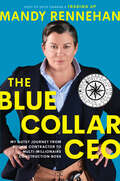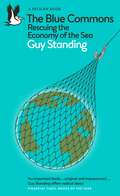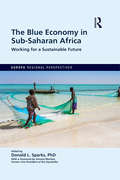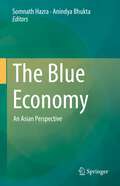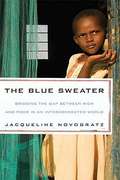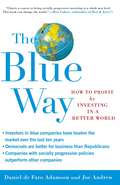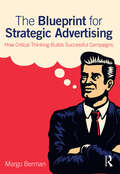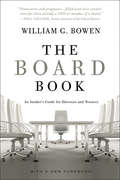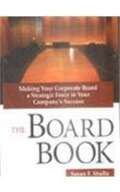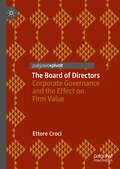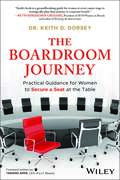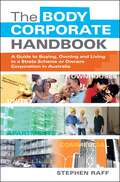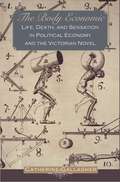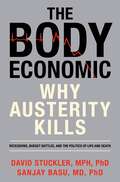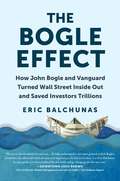- Table View
- List View
The Blue Collar CEO: My Gutsy Journey from Rookie Contractor to Multi-Millionaire Construction Boss
by Mandy RennehanBorn in Yarmouth, Nova Scotia, Mandy Rennehan began her business career at age ten, catching bait and selling it to local fishermen. She was so good at her job, she was soon out-earning her father, a local lobster fisherman. At the age of seventeen, Rennehan decided to strike out on her own, so she packed a hockey bag and fled to Halifax, where she began cold-calling construction companies, volunteering to work for free so she could learn more about contracting and the trades. Three years later, Rennehan had garnered all the experience she needed to start her own company, Freshco, a boutique retail-maintenance and construction company. While Rennehan was still in her early twenties, her reputation as a knowledgeable and trustworthy contractor led to her first corporate contract with The Gap. Freshco has since become a multi-million-dollar company whose clients include Apple, Lululemon, Tiffany & Co., Sephora, Anthropologie, Nike and Home Depot, to name but a few. Known as “the blue-collar CEO” for her ability to seamlessly navigate between the white- and blue-collar worlds, Rennehan is a tireless advocate for the trades. Her savvy business skills and innovative thinking took her to the top of a male-dominated industry before she reached the age of thirty. This book is the “respectfully uncensored” story of how Rennehan succeeded in business through honesty, integrity and most of all, authenticity: by always remaining true to herself and her vision for success.
The Blue Commons: Rescuing the Economy of the Sea (Pelican Books)
by Guy StandingA FINANCIAL TIMES BEST ECONOMICS BOOK OF 2022 'A landmark book... The Blue Commons is at once a brilliant synthesis, a searing analysis, and an inspiring call to action.' - David Bollier'With remarkable erudition, passion and lyricism, Guy Standing commands the reader to wake up to the threat posed by rentier capitalism's violent policies for extraction, exploitation and depletion of that which is both common to us all, but also vital to our survival: the sea and all within it.' - Ann Pettifor 'Shines a bright light on the economy of the oceans, directing us brilliantly towards where a sustainable future lies.' - Danny Dorling'This is a powerful, visionary book - essential reading for all who yearn for a better world.' - Jason HickelThe sea provides more than half the oxygen we breathe, food for billions of people and livelihoods for hundreds of millions. But giant corporations are plundering the world's oceans, aided by global finance and complicit states, following the neoliberal maxim of Blue Growth. The situation is dire: rampant exploitation and corruption now drive all aspects of the ocean economy, destroying communities, intensifying inequalities, and driving fish populations and other ocean life towards extinction.The Blue Commons is an urgent call for change, from a campaigning economist responsible for some of the most innovative solutions to inequality of recent times. From large nations bullying smaller nations into giving up eco-friendly fishing policies to the profiteering by the Crown Estate in commandeering much of the British seabed, the scale of the global problem is synthesised here for the first time, as well as a toolkit for all of us to rise up and tackle it.The oceans have been left out of calls for a Green New Deal but must be at the centre of the fight against climate change. How do we do it? By building a Blue Commons alternative: a transformative worldview and new set of proposals that prioritise the historic rights of local communities, the wellbeing of all people and, with it, the health of our oceans.
The Blue Economy in Sub-Saharan Africa: Working for a Sustainable Future (Europa Regional Perspectives)
by Donald L. SparksThe blue economy, comprising coastal and marine resources, offers vast benefits for sub-Saharan Africa: of the 53 countries and territories in the region, 32 are coastal states; there are 13 million sq km of maritime zones; more than 90% of the region’s exports and imports come by sea; and the African Union hails the blue economy as the ‘new frontier of African renaissance’. Despite their importance, the region’s coastal and marine resources have been neither fully appreciated nor fully utilized. They are only now being recognized as being key to Africa’s potential prosperity. As the region grows, it has, in general, not taken adequate safeguards to protect these valuable resources. That is partly because some of the problems (pollution, for example) are regional and know no borders. All too often, short-term gains are made at the expense of the long term (overfishing, for example). This book provides, for the first time, a study of the constraints and opportunities the blue economy offers for sub-Saharan Africa. It includes an introduction and overview; sectoral analyses (including tourism, fisheries, mineral resources, culture, shipping and maritime safety); country case studies; and analyses of regional and international efforts towards better coastal zone and marine management.
The Blue Economy: An Asian Perspective
by Somnath Hazra Anindya BhuktaThis volume defines and analyzes the Blue Economy, a system that encompasses all the economic activities which are happening in and around the ocean within a sustainable development framework, with focus on countries in Asia. This work is timely, as Blue Economy activities account for a significant share of GDPs in the island and coastal economies in the Asia region, sustaining the livelihoods of one of the largest sections of the world's population. This book, therefore, assesses how the Blue Economy contributes to these livelihoods from economic and ecological perspectives and analyzes the various types of ecosystem services provided, and how these services are regulated and maintained. While most studies of the Blue Economy focus only on the economic aspects, this book provides ample statistical data to demonstrate why ecosystem services should additionally be considered for the estimation and valuation of the Blue economy. The book is primarily meant for researchers, students, and teachers in the fields of environmental and ocean economics, sustainable development, and ecosystem services, and will be of further interest to policymakers and government officials working in matters related to the Blue Economy and sustainability policy.
The Blue Line Imperative
by Kevin Kaiser S. David YoungA groundbreaking guide to making profitable business decisionsDo you wonder why your value initiatives aren't providing the payoff you'd hoped for? Could it be because you've been thinking about value all wrong? According to the authors of this groundbreaking guide, there's a very good chance that you have. Using examples from leading companies worldwide, they explain why every decision a company makes either creates value or detracts from it, and why, if they hope to survive and thrive in today's increasingly competitive global marketplace, company leaders must make value-creation the centrepiece of every business decision. Authors Kaiser and Young have dubbed this approach "Blue-Line Management," (BLM), and in this entertaining, highly accessible book, they delineate BLM principles and practices and show you how to implement them in your company.Explains why the failure to properly define and assess value often makes it difficult for the people who manage businesses to effect long-term successOffers guidelines for making the satisfaction of customer needs and wants--i.e. value creation--the driver of all business activitiesThe authors are respected academics at INSEAD, the world's largest and most respected graduate business school, with campuses in Europe, Asia and the Middle East
The Blue Line Imperative: What Managing for Value Really Means
by Kevin Kaiser S. David YoungA groundbreaking guide to making profitable business decisions Do you wonder why your value initiatives aren't providing the payoff you'd hoped for? Could it be because you've been thinking about value all wrong? According to the authors of this groundbreaking guide, there's a very good chance that you have. Using examples from leading companies worldwide, they explain why every decision a company makes either creates value or detracts from it, and why, if they hope to survive and thrive in today's increasingly competitive global marketplace, company leaders must make value-creation the centrepiece of every business decision. Authors Kaiser and Young have dubbed this approach "Blue-Line Management," (BLM), and in this entertaining, highly accessible book, they delineate BLM principles and practices and show you how to implement them in your company. Explains why the failure to properly define and assess value often makes it difficult for the people who manage businesses to effect long-term success Offers guidelines for making the satisfaction of customer needs and wants—i.e. value creation—the driver of all business activities The authors are respected academics at INSEAD, the world's largest and most respected graduate business school, with campuses in Europe, Asia and the Middle East
The Blue Sweater: Bridging the Gap Between Rich and Poor in an Interconnected World
by Jacqueline NovogratzThe Blue Sweater is the inspiring story of a woman who left a career in international banking to spend her life on a quest to understand global poverty and find powerful new ways of tackling it. It all started back home in Virginia, with the blue sweater, a gift that quickly became her prized possession—until the day she outgrew it and gave it away to Goodwill. Eleven years later in Africa, she spotted a young boy wearing that very sweater, with her name still on the tag inside. That the sweater had made its trek all the way to Rwanda was ample evidence, she thought, of how we are all connected, how our actions—and inaction—touch people every day across the globe, people we may never know or meet.From her first stumbling efforts as a young idealist venturing forth in Africa to the creation of the trailblazing organization she runs today, Novogratz tells gripping stories with unforgettable characters—women dancing in a Nairobi slum, unwed mothers starting a bakery, courageous survivors of the Rwandan genocide, entrepreneurs building services for the poor against impossible odds. She shows, in ways both hilarious and heartbreaking, how traditional charity often fails, but how a new form of philanthropic investing called "patient capital" can help make people self-sufficient and can change millions of lives. More than just an autobiography or a how-to guide to addressing poverty, The Blue Sweater is a call to action that challenges us to grant dignity to the poor and to rethink our engagement with the world.
The Blue Sweater: Bridging the Gap between Rich and Poor in an Interconnected World
by Jacqueline NovogratzThe Blue Sweater is the inspiring story of a woman who left a career in international banking to spend her life on a quest to understand global poverty and find powerful new ways of tackling it.
The Blue Way
by Joe Andrew Daniel De AdamsonTurning conventional wisdom on its head, The Blue Way shows why socially progressive companies that make political contributions to "blue" politicians and causes outperform "red" companies. The idea that progressives are better at businesses than conservatives will surprise most people - including many progressives. But as The Blue Way shows, in nearly every sector of the economy, blue companies are the top performers. As a result, an investor who places his money in stocks of blue companies will do better than one who chooses red companies or who chooses to invest in the market as a whole. In The Blue Way, Daniel Adamson and Joe Andrew, cofounders of Blue Investment Management, identify the companies that have the most progressive social values - fair wages, equal opportunity, environmental responsibility - and also contribute to progressive political causes (or are at least neutral). They describe the portfolio they have built around those companies, which to date has out-performed the market. Their innovative investment strategy offers a profitable approach for investors seeking a principled and successful stock portfolio. But The Blue Way is also a stirring manifesto, a call to embrace socially and politically progressive values. As the authors show, these values aren't anti-business; they are pro-American. For decades the American economy has performed better under Democratic administrations than under Republicans. Americans who "buy blue," say Adamson and Andrew, aren't just acting on their values; they are helping to grow the American economy. The authors explain how to build a "blue infrastructure," a progressive ecosystem in which companies and activists with progressive values can support blue politicians and causes. The Blue Way shows how the progressive movement can learn from the success of the blue business world and create a new progressive majority for the future. The Blue Way describes a revolutionary investment strategy back by solid financial research that benefits investors while fostering socially progressive American values.
The Blueprint for Strategic Advertising: How Critical Thinking Builds Successful Campaigns
by Margo BermanThe Blueprint for Strategic Advertising’s step-by-step approach takes a comprehensive and exclusive look into the strategic use of visual, verbal, social media, integrated, and global of advertising communication. Its deconstructive process analyzes one aspect at a time, creating an invaluable research tool that students, professors, small business owners and entrepreneurs will refer to, time and again. This useful guide will concentrate on how strategy is integrated into visual and verbal ideation. Berman’s compact, content-rich guide offers chapters detailing social media, user-centered interactive advertising, and presentation strategy, closing with the creation of a "blueprint" to strategizing globally. Features include a handy reference guide to powerful strategizing, an exploration of strategies for myriad media and messaging vehicles, and an examination of the strategic implementation of the visual and verbal union. This guide will be useful to students in advertising, marketing, and business courses as well as advertising professionals and entrepreneurs, outside the classroom.
The Blueprint: 6 Practical Steps to Lift Your Leadership to New Heights
by Douglas R. ConantLift your leadership to new heightsDoug Conant, Founder of ConantLeadership, former CEO of Campbell Soup Company, and former President of Nabisco Foods, shares transformational insights in his new book, The Blueprint. Conant is the only former Fortune 500 CEO who is a New York Times bestselling author, a top 50 Leadership Innovator, a Top 100 Leadership Speaker, and a Top 100 Most Influential Author in the World. Get Unstuck In 1984, Doug Conant was fired without warning and with barely an explanation. He felt hopeless and stuck but, surprisingly, this defeating turn of events turned out to be the best thing that ever happened to him. Doug began to consider what might be holding him back from realizing his potential, fulfilling his dreams, and making a bigger impact on the world around him. Embarking on a journey of self-reflection and discovery, he forged a path to revolutionize his leadership and transform his career trajectory. Ultimately, Doug was able to condense his remarkable leadership story into six practical steps. It wasn't until Doug worked through these six steps that he was able to lift his leadership to heights that ultimately brought him career success, joy, and fulfillment. Reach High - Envision Dig Deep - Reflect Lay the Groundwork - Study Design - Plan Build - Practice Reinforce - Improve In The Blueprint, part leadership manifesto, part practical manual, Doug teaches leaders how to work through the same six steps that he used to transform his journey. The six steps are manageable and incremental, designed to fit practically within the pace of busy modern life. Knowing how daunting the prospect of change can be, Doug arms readers with exercises and practices to realistically bring their foundation to life in every situation. Now, today’s leaders who feel stuck and overwhelmed finally have a blueprint for lifting their leadership to make meaningful change in their organizations and in the world.
The Board Book: An Insider's Guide for Directors and Trustees
by William G. Bowen"By far the best book on corporate and institutional governance." --Nicholas Katzenbach, former attorney general of the United States In his new foreword to The Board Book, former Mellon Foundation and Princeton University president William G. Bowen brings his immense experience to bear on the most pressing questions facing boards of directors and trustees today: seeking collaborative relationships and placing a renewed emphasis on sustainable initiatives. The strategies Bowen relates throughout the book foster the collegiality and sense of purpose--more important in today's turbulent times than ever before--that are integral to any effective board.
The Board Book: Making Your Corporate Board a Strategic Force in Your Company's Success
by Susan F. ShultzThe Board Book is the most succinct, reader-friendly guide available to recruiting and managing on-track, top-notch corporate boards.
The Board and the CEO: Seven Practices to Protect Your Organization's Most Important Relationship
by Peter Greer David Weekley Tiger DawsonGood relationships lie at the heart of every successful organization. Yet no relationship is more important—or more challenging—to navigate than the one between the board and the CEO. In this practical and concise book, Peter Greer and David Weekley draw from their years of experience to equip board members and organizational leaders to enter into an impactful, life-giving partnership. With this pivotal relationship in place, individuals and the organizations they serve can truly flourish.
The Board of Directors and Audit Committee Guide to Fiduciary Responsibilities: Ten Crtical Steps to Protecting Yourself and Your Organization
by Ronald Kral Sheila MoranMore than three million people serve on boards and audit committees in the U.S. alone. But huge risks come with these coveted jobs. SEC scrutiny is at an all-time high, with boards and audit committees now held liable to for acts of fraud and other corporate malfeasance--even if they had no knowledge of wrong-doing in the organization. This essential guide mitigates the risks and dramatically increases the effectiveness of boards and audit committees by uncovering 10 crucial steps every governing body should take, including: * Cultivate independence * Build a balanced team * Leverage independent advisors * Address stakeholder concerns * Direct the external audit * Approach risk proactively * Spearhead fraud deterrence initiatives * Promote accountability * And more Comprehensive and practical, this book simplifies complex corporate governance standards, and helps readers satisfy the requirements of board service while protecting themselves and the organization.
The Board of Directors at Market Basket
by Jay W. Lorsch Emily MctagueThe firing of Market Basket CEO Arthur T. Demoulas by his cousin, Arthur S. Demoulas, and directors affiliated with Arthur set off employee protests throughout the grocery store chain. Industry specialists estimated that Market Basket was losing close to $10 million each day in lost business and inventory, due to the protests. A long history of legal battles had destroyed the relationship between the families of the 2 cousins. This case describes the complexities of corporate governance for a family-owned organization.
The Board of Directors: Corporate Governance and the Effect on Firm Value
by Ettore CrociBoards of directors are a central feature of any corporate governance regime. The role of directors and how they affect firm value and policies is examined in depth in academic literature. However, it is easy to get both lost and overwhelmed when searching through the literature review that investigates several characteristics, often one at the time. This book provides a careful and concise look at corporate finance literature, specifically with regard to the board of directors, summarizing the main findings and reconciling them. This book documents the pros and cons associated with the various attributes of the board and the directors as found in the current literature and provides sections geared specifically to practitioners in this space, as well, allowing for a better and more comprehensive description of this important corporate governance mechanism. The resulting book aims to facilitate the interpretation of changes in corporate governance through the lens of the recent academic literature.
The Boardroom Journey: Practical Guidance for Women to Secure a Seat at the Table
by Keith D. DorseyEmpower your journey to the corporate boardroom with practical guidance and real-life examples. The Boardroom Journey: Practical Guidance for Women to Secure a Seat Table by Dr. Keith D. Dorsey offers a clear, actionable roadmap for women at any career stage to strategically build a path to the boardroom. The evidence-based strategies and inspiring success stories presented throughout this book have been gleaned from interviews with hundreds of current corporate board members. Specific tactics are outlined for early career professionals shaping their leadership journey, mid-career professionals navigating their way to the C-suite, and current and retired C-suite executives actively seeking their first (or next) corporate board seat. This book helps readers navigate the nuances of these journeys by moving from theoretical insights to actionable advice. The Boardroom Journey is an invaluable guide that helps women assess their personal motivations for career growth and board service, identify suitable boards, and enhance their board readiness through assessment tools and exercises. The book also offers strategies for building and leveraging a network of mentors, sponsors, and allies to gain support and boost confidence throughout the board journey. Inside the book: Discover strategies to effectively prepare for board service Gain insights on how to present and differentiate oneself via five types of capital Learn how to build and leverage a support team The Boardroom Journey is perfect for anyone aspiring to bring their unique perspective to corporate governance. The evidence-based strategies offered here give readers a proven method for charting an intentional path to executive service and securing a seat at the corporate boardroom table.
The Body Corporate Handbook: A Guide to Buying, Owning and Living in a Strata Scheme or Owners Corporation in Australia
by Stephen RaffPopulation growth, rising property prices and the dream of a new lifestyle have made body corporate living more and more popular in Australia. Living in an apartment, unit or townhouse can be a rewarding experience, but body corporate life can also be confusing. In this book, expert author Stephen Raff clarifies the rules and answers vital questions such as: What should I look out for when buying a strata property? What are the responsibilities of the body corporate, owners and tenants? How do committee meetings work? What fees will I have to pay? Who takes care of maintenance? What happens if I get into a dispute? Packed with revealing case studies and state-specific information, The Body Corporate Handbook is a comprehensive guide to every aspect of strata life for owner-occupiers, tenants and investors.
The Body Economic: Life, Death, and Sensation in Political Economy and the Victorian Novel
by Catherine GallagherThe Body Economic revises the intellectual history of nineteenth-century Britain by demonstrating that political economists and the writers who often presented themselves as their literary antagonists actually held most of their basic social assumptions in common. Catherine Gallagher demonstrates that political economists and their Romantic and early-Victorian critics jointly relocated the idea of value from the realm of transcendent spirituality to that of organic "life," making human sensations--especially pleasure and pain--the sources and signs of that value. Classical political economy, this book shows, was not a mechanical ideology but a form of nineteenth-century organicism, which put the body and its feelings at the center of its theories, and neoclassical economics built itself even more self-consciously on physiological premises. The Body Economic explains how these shared views of life, death, and sensation helped shape and were modified by the two most important Victorian novelists: Charles Dickens and George Eliot. It reveals how political economists interacted crucially with the life sciences of the nineteenth century--especially with psychophysiology and anthropology--producing the intellectual world that nurtured not only George Eliot's realism but also turn-of-the-century literary modernism.
The Body Economic: Why Austerity Kills
by Sanjay Basu David StucklerPoliticians have talked endlessly about the seismic economic and social impacts of the recent financial crisis, but many continue to ignore its disastrous effects on human health—and have even exacerbated them, by adopting harsh austerity measures and cutting key social programs at a time when constituents need them most. The result, as pioneering public health experts David Stuckler and Sanjay Basu reveal in this provocative book, is that many countries have turned their recessions into veritable epidemics, ruining or extinguishing thousands of lives in a misguided attempt to balance budgets and shore up financial markets. Yet sound alternative policies could instead help improve economies and protect public health at the same time. In The Body Economic, Stuckler and Basu mine data from around the globe and throughout history to show how government policy becomes a matter of life and death during financial crises. In a series of historical case studies stretching from 1930s America, to Russia and Indonesia in the 1990s, to present-day Greece, Britain, Spain, and the U. S. , Stuckler and Basu reveal that governmental mismanagement of financial strife has resulted in a grim array of human tragedies, from suicides to HIV infections. Yet people can and do stay healthy, and even get healthier, during downturns. During the Great Depression, U. S. deaths actually plummeted, and today Iceland, Norway, and Japan are happier and healthier than ever, proof that public wellbeing need not be sacrificed for fiscal health. Full of shocking and counterintuitive revelations and bold policy recommendations, The Body Economic offers an alternative to austerity—one that will prevent widespread suffering, both now and in the future.
The Body Machines
by Alexander Bard Jan SöderqvistThe final episode of The Futurica Trilogy. It departs from repeated questions about the Death of the Individual in the Age of Interactivity. The authors rehabilitate Descartes old concept of the body machine and transform it into the foundation of a very anti-cartesian, materialist image of humanity, relevant for the new, emerging paradigm--we're entering The Age of The Body Machines.
The Body in Late-Capitalist USA
by Donald M. LoweIn The Body in Late-Capitalist USA, Donald M. Lowe explores the varied social practices that code and construct the body. Arguing that our bodily lives are shaped by a complex of daily and ongoing practices--how we work, what we buy and consume--Lowe contends that as a result of the commodification of these and other social practices in the late-twentieth century, what we often understand to be the needs of the body are in fact means for capital accumulation. Moving beyond studies of representations and images of the body, Lowe focuses on the intersection of body practices, language, and the Social to describe concretely the reality of a lived body. His strongly synthetic work brings together Marxist critique, semiotics, Foucaultian discourse analysis, and systems and communications theory to examine those practices that construct the body under late capitalism: habits of work and consumption, the ways we give birth and raise children, socialization, mental and physical healing, reconstructions and contestations of sexuality and gender. Lowe draws upon a wide range of sources, including government and labor studies and statistics, diagnostic and statistical manuals on mental illness, computer manuals, self-help books, and guides to work-related stress disorders, to illustrate the transformation of the body into a nexus of exchange value in postmodern society.
The Body of Money: A Self-Help Guide to Creating Sustainable Wealth through Innate Intelligence
by Gayle ColmanIn a world gone mad with money The Body of Money: A Self-Help Guide to Create Sustainable Wealth through Innate Intelligence is a comprehensive guide to building and sustaining wealth by using the incredible intelligence of the human body. The story you’ve been told about money is all wrong. Spreadsheets, PNL’s, money markets, and index funds only touch the surface. The Body of Money provides a completely unique and effective approach to personal finance like nothing you’ve experienced before. By demystifying money psychology and behavior economics Certified Financial Planner® and Master Integral Coach™ Gayle Colman shows you exactly how to use your innate wisdom to heal old money patterns, tend to wounds created by generational financial trauma and create sustainable wealth that is aligned with your deepest values. Integrating cutting-edge research, laugh-out-loud storytelling and body-centered practices, Gayle puts the power of individual wealth–building squarely back in your own hands. You will learn: How body practices can have a transformative effect on your money habits. Where your personal money manager lives in your body and how to access its true wisdom. Why investing in a way that matches your personal values can actually be better for your health. How to use your body to gain true financial agency, reduce debt, invest in real estate and make the most important money decisions of your life. The Body of Money is an indispensable approach to personal finance, perfect for any person seeking relief from money struggles and all individuals and families who want to create a robust and healthy money legacy for their lives.
The Bogle Effect: How John Bogle and Vanguard Turned Wall Street Inside Out and Saved Investors Trillions
by Eric BalchunasThe index fund wouldn&’t be jack without Jack. It was just one innovation fueled by The Vanguard Group founder Jack Bogle&’s radical idea in 1975 to make investors the actual owners of his new fund company. While the move was as much to save his job as it was to save investors, the end result was powerful: a fund company for the people and by the people. Bogle began a 50-year process of lowering costs inch by inch, which ultimately unleashed a populist revolt that has saved average investors trillions of dollars while reforming and right-sizing much of the entire financial industry. Today, nearly every dollar invested in America goes to either Vanguard funds or Vanguard-influenced funds. But Bogle&’s impact and this &“great cost migration&” reaches well beyond index funds into many other areas, such as active management, ETFs, the advisory world, quantitative investing, ESG, behavioral finance and even trading platforms. The Bogle Effect takes readers through each of these worlds to show how they—and the investors they serve—are being reshaped and reformed. While hundreds of fund providers have copied the index fund that Vanguard made popular no one is yet to copy its &“mutual&” ownership structure. Why? This book explores that question as well as what made Bogle such an anomaly—seemingly immune to the overwhelming magnet of ambition that dictates Wall Street, made famous by movies like Wall Street, The Big Short, and The Wolf of Wall Street. On the flip side, Bogle wasn&’t perfect by any stretch—he could be moralizing, cantankerous, and tended to make virtue out of necessity. The Bogle Effect is animated by the author&’s hours of one-on-one, exclusive interviews with Bogle in the years before he passed, which reveal his philosophy, vision, intellect, and humor. Dozens of additional interviews with people who worked with him, lived with him, were influenced by him, and disagreed with him round out a portrait of this revolutionary figure. You will never look at the financial industry or your portfolio the same way again.
